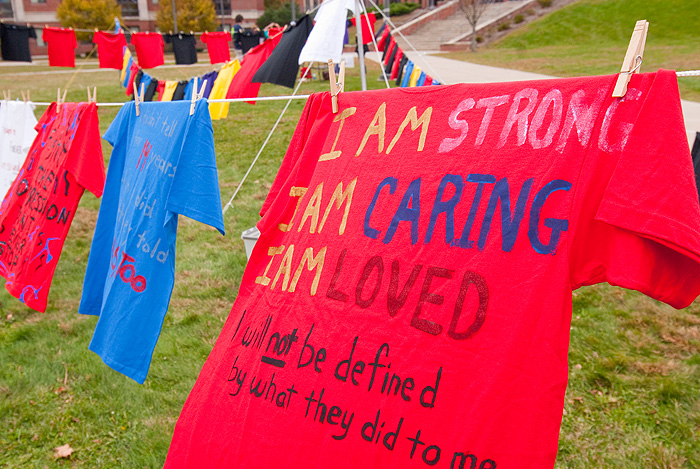Julier starts off by comparing Clothesline Project (in which shirts are strung on a clothesline, each created anonymously by an individual women about her experience of violence against women) to the Vietnam Wall and the AIDS quilt. She says, "..each project points to the complex relationship between individual pain or grieving and a collective social responsibility for the problem...some claim that individual healing occurs because in these projects the individual experience is recognized as part of a larger social problem." I can't help but think of the why I need feminism project that's happening this week on Ithaca's campus, where women and men are asked to have their picture taken with a small whiteboard on which they fill in "I need feminism because..."
While many of the text created by this movement is, I believe, more filtered and less striking as some of the shirts referenced in this chapter. This adds to what makes the Clothesline Project so powerful. Some of the shirts that Julier sites remind me much of Audre Lorde's recognition of her experience of violence against her as a woman in her autobiography I Know Why the Caged Bird Sings. Similar to my experience reading Lorde's story, I physically cringed as I read these women's stories, as little or much as I did come to understand the logistics of them. But that is not the goal here, as Julier reminds us by drawing the line between statistics and a physical army of women, "almost flesh," standing at a radical intersection between public and private speaking. One caretaker of the Mid-Michigan Clothesline Project reminds us, "We must never forget, for every statistic, every theory, a woman, a life" (379). The shirts act as physical and emotional reminders for both participants and on-lookers.
The most provocative part of this project for me is the singular specification for the creation of this social text: "A woman will have complete control over her speaking, its form, its content, its audience, and its purpose, her speaking out will be protected, and her text will join others and will not stand alone." Reading this, it is disturbing to think about how often that is not the case for women, as arguably as it is for men, in our current shared, public spaces. The specification of the woman's voice joining others brings me back to the second chapter of this book, in which Anne Gere speaks about the individual voice not as autonomous but rather in a relationship with other voices. This idea of community support and understanding is a reoccurring theme in the idea of writing and healing, and I find it very telling of how alienating and isolating the silence of struggle can be.

No comments:
Post a Comment